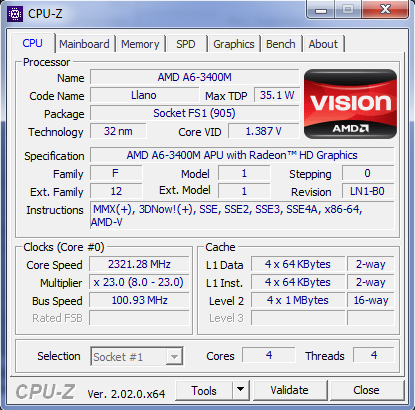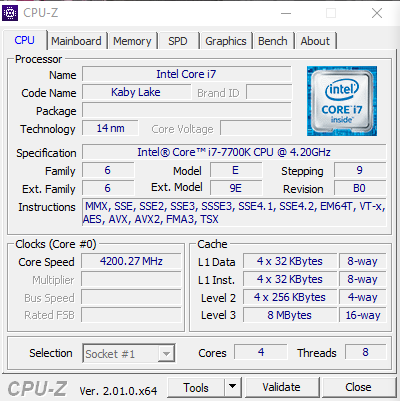Comparing: AMD A6-3400M vs Intel Core i7 7700K
In this comparison, we analyze two Processors: AMD A6-3400M and Intel Core i7 7700K, using synthetic benchmark tests to evaluate their overall performance. This side-by-side comparison helps users understand which hardware delivers better value, speed, and efficiency based on standardized testing. Whether you're building a new system or upgrading an existing one, this benchmark-driven evaluation offers valuable insights to guide your decision.
Specification Comparison Table
| Specification | AMD A6-3400M | Intel Core i7 7700K |
|---|---|---|
| Architecture | x86 | x86 |
| Technology | 32 nm | 14 nm |
| Clock | 1.4 GHz - 2.3 GHz | 4.2 GHz - 4.5 GHz |
| Core/Thread | 4 / 4 | 4 / 8 |
| Segmen | Mobile | Desktop |
Submission Comparison Table
| Benchmark Software | AMD A6-3400M | Intel Core i7 7700K |
|---|---|---|
| Cinebench - 2003 |
765 cb |
4315 cb |
| Cinebench - R11.5 |
1.79 pts |
9.59 pts |
| Cinebench - R15 |
153 cb |
867 cb |
| Cinebench - R20 |
291 pts |
2222 pts |
| PiFast |
1min, 14sec, 310ms |
14sec, 730ms |
| SuperPi - 1M |
46sec, 984ms |
30sec, 414ms |
About Hardware AMD A6-3400M
Launched in mid-2011, the AMD A6-3400M is a mobile processor from the Llano family designed for mid-range laptops. It has 4 cores and 4 threads with a base speed of 1.4 GHz, which can increase to 2.3 GHz thanks to the Turbo Core feature. Built with a 32nm fabrication process, the A6-3400M offers pretty good power efficiency with a TDP of 35W, making it a common choice for mainstream laptops in its day.
In addition to the CPU, the A6-3400M is also integrated with the AMD Radeon HD 6520G GPU, which has 320 shader cores based on the Terascale 2 architecture. This combination of CPU and GPU enables sufficient graphics processing for everyday tasks and light gaming at low resolutions.
In terms of performance, the A6-3400M is capable of handling basic tasks such as browsing, multimedia, and productivity applications. However, compared to the same generation of Intel Core i3 processors, its performance is less competitive especially in single-threaded applications.
Hardware Tested:
Device: Lenovo Sabine B475
RAM: 2GB DDR3
OS: Windows 7
Thursday, 24 November 2022 05:29:20 | Update: 1 week ago
About Hardware Intel Core i7 7700K
Part of the Kaby Lake generation, the Intel Core i7-7700K is a high-end desktop processor released in 2017. It has 4 cores and 8 threads, with a base clock speed of 4.2 GHz and can increase to 4.5 GHz with Turbo Boost.
Built with 14nm fabrication, the i7-7700K has a TDP of 91W, so it requires a good cooling solution, especially in overclocking configurations. As it is a “K” series, this processor has an unlocked multiplier, allowing users to boost the clock speed higher with a motherboard that supports overclocking.
For graphics, the processor comes with Intel HD Graphics 630, which is sufficient for basic display but not optimal for gaming without a discrete graphics card.
In terms of performance, the i7-7700K is still strong enough for gaming and productivity, but compared to modern processors that have more cores and better efficiency, its competitiveness starts to decline, especially in multi-threaded applications.
Thursday, 23 June 2022 07:42:37 | Update: 1 week ago


